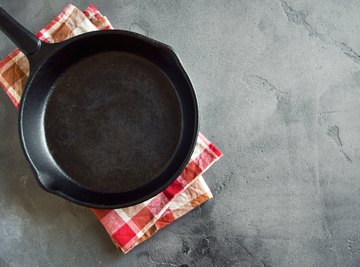
Cast iron is iron mixed with small amounts of silicon and carbon, and cast -- rather than formed -- in place. It is a strong structural material and also a good conductor of heat, making it a common material for cookware. There are four basic types of cast iron: ductile, malleable, white and grey. There are several differences in the composition and use of white and grey cast iron.
Interior Appearance
The "grey" and "white" in the names of grey and white cast iron refer to the appearance of their interiors; when split open, a piece of grey cast iron ranges from pale to dark grey, while white cast iron is much lighter.
Melting
Grey cast iron will melt at 1600 degrees Celsius, at which point it transitions quickly from a solid to a fully liquid state. White cast iron melts at a slightly lower temperature, but does so more gradually; it remains in a semi-solid state for some time before liquefying.
Cooling
White cast iron, if cooled very slowly from melting, will become grey cast iron as the carbon atoms inside it bond together. Grey cast iron, by contrast, will keep its form if cooled slowly, but will become white cast iron if cooled very fast.
Hardness and Strength
White cast iron is harder than grey, to the point that it is quite brittle. Grey iron, by contrast, is softer but stronger. The two types are sometimes combined, allowing a piece to be made with a hard outer coating of white iron and a strong core of grey.
Carbon Chemistry
The carbon in grey cast iron is just mixed in amongst the iron molecules; in white cast iron, the iron and carbon are actually combined. In chemistry, "combination" and "mixing" don't mean the same thing; "combination" implies the two substances -- in this case, carbon and iron -- have chemically bonded together. The overall carbon content of grey cast iron is between 2 and 4.65 percent, while white cast iron has between 3 and 5.75 percent carbon.
Contraction
When cast iron cools from melting, it contracts. Grey cast iron contracts by approximately 1 percent, while white cast iron contracts by between 2 and 2.5 percent.
Oxidization
Oxidization is the process by which oxygen combines with the metal molecules to form rust. Grey cast iron rusts much faster than white at low temperatures, while at high temperatures, the relationship is reversed.
Silicon Content
White cast iron contains between 0.1 and 0.5 percent silicon, while grey cast iron has between 0.5 and 3.5 percent.
References
About the Author
Joshua Smyth started writing in 2003 and is based in St. John's, Newfoundland. He has written for the award-winning "Cord Weekly" and for "Blueprint Magazine" in Waterloo, Ontario, where he spent a year as editor-in-chief. He holds a Bachelor of Arts in political science and economics from Wilfrid Laurier University.
